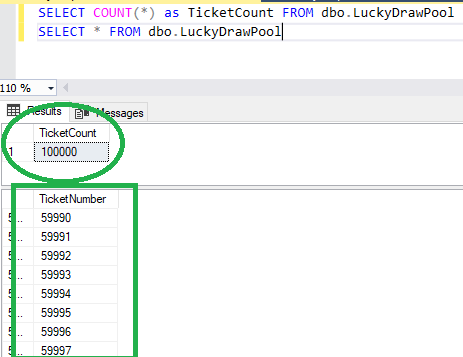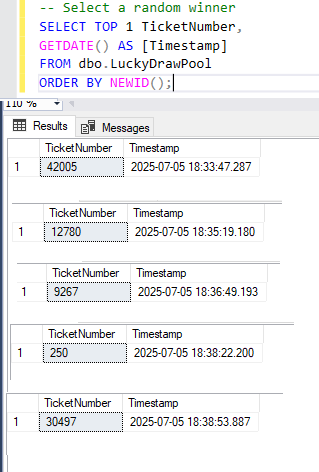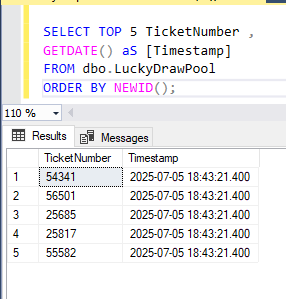Want to randomly pick a winner from a list of participants? Whether you’re running an office contest, event giveaway, or an online reward program, a Lucky Draw System can be easily built using SQL Server—no fancy tools or coding required!
Why SQL Server for a Lucky Draw?
- Quick and easy implementation using existing SQL skills
- Built-in randomness with NEWID()
- Ideal for one-time or recurring draws
- No external apps or scripts needed
Step 1: Create a Pool of Ticket Number
Let’s create a table filled with ticket numbers from 1 to 100,000, representing eligible entries:
-- Create the table
CREATE TABLE dbo.LuckyDrawPool (
TicketNumber INT PRIMARY KEY
);
-- Populate with numbers from 1 to 100000
WITH Numbers AS (
SELECT 1 AS TicketNumber
UNION ALL
SELECT TicketNumber + 1 FROM Numbers WHERE TicketNumber < 100000
)
INSERT INTO dbo.LuckyDrawPool (TicketNumber)
SELECT TicketNumber FROM Numbers
OPTION (MAXRECURSION 0);

Step 2: Drawing a Random Winner
Use the NEWID() function in SQL Server to shuffle the entries and select a random ticket number:
-- Select a random winner
SELECT TOP 1 TicketNumber,
GETDATE() AS [Timestamp]
FROM LuckyDrawPool
ORDER BY NEWID();
Every time this query runs, it returns a new random entry—just like a digital Lucky Draw!

Step 3: Enhance the System
How to get multiple Winners (Top 5 Winners)
SELECT TOP 5 TicketNumber ,
GETDATE() aS [Timestamp]
FROM dbo.LuckyDrawPool
ORDER BY NEWID();

Track Past Winners
CREATE TABLE dbo.LuckyDrawWinners (
WinnerID INT PRIMARY KEY IDENTITY,
TicketNumber INT,
WinDate DATETIME DEFAULT GETDATE()
);
-- Save current winner
INSERT INTO dbo.LuckyDrawWinners (TicketNumber)
SELECT TOP 1 TicketNumber FROM dbo.LuckyDrawPool ORDER BY NEWID();
Prevent Repeat Winners
SELECT TOP 1 TicketNumber
FROM dbo.LuckyDrawPool
WHERE TicketNumber NOT IN (SELECT TicketNumber FROM LuckyDrawWinners)
ORDER BY NEWID();
Use Case(s)
- Employee recognition and bonus programs
- Event-based giveaways and marketing contests
- Random sampling for QA testing or analytics
- Simulating randomness in data modeling pipelines
- Online Contest Winners
- Gamification in dashboards